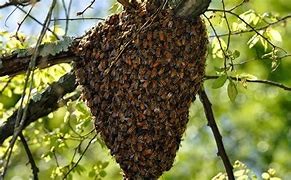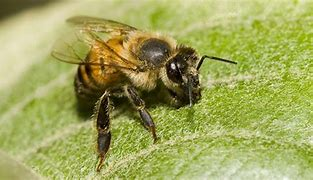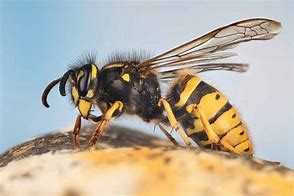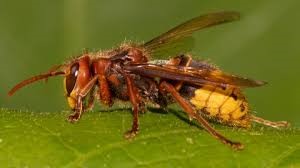Bees and Wasps – First Identify, Then Treat
There are fewer things that can ruin an outdoor activity than stumbling upon a bee or wasp hive. This is particularly true if you have an allergy to bee and wasp stings. For those with allergies, a bee sting can be more than painful, it can be deadly.

The Problem: Stinging Pests
There are a large number of bee and wasp species. Nearly every species of bee or wasp is prone to attack and nearly all of them have stingers. These stingers deliver a painful pinch and are loaded with venom. For some a sting means a painful bump, but for others a bee or wasp sting can cause an allergic reaction and anaphylactic shock.
The problem with disturbing a hive when trying to conduct bee removal and especially wasp removal is that the victim can receive multiple stings. If the nest that has been disturbed is a wasp or hornet nest a single insect can sting multiple times, injecting venom repeatedly.
Know the types of bees and wasps
Some species of bees and wasps are prone to sting in large numbers and include:
- Africanized honeybee – or killer bees, are a hybrid between the European and African subspecies, are an excellent example of a stinging insect that can do great bodily harm to humans. Africanized bees are very aggressive, attacking in great numbers upon hearing loud noises or whenever a hive or nest is disturbed.

These bees can be life-threatening not just to those prone to allergic reactions but people (or animals) with limited capacity to escape, such as small children, the elderly or handicapped. If the hive is threatened, these bees can attack in great numbers and have been known to travel 50 yards or more in pursuit of the perceived threat. Hundreds of bees detecting you as a threat can result in hundreds of stings.
- Yellow jackets – probably one of the better-known species of stinging insect. They can pack an extremely painful punch, so it’s better to stay afar of any hive or nest just in case you’ve come across an aggressive species.

- Hornets – in the wasp family of insects and similar to yellow jackets albeit larger and typically red/brown in coloration, these insects attack when their hives are disturbed, or a drone hornet is killed. Hornets can sting multiple times because their stingers are not barbed like the honeybee, so they are not lost when they sting.

In general, bees are considered beneficial insects that manufacture delicious honey and pollinate plants. However, bees can do extensive damage to a building if they nest inside the walls, and some may sting humans if provoked.
One of the keys to successful bee and wasp nest treatments and removal if needed is identifying the species of bee and wasp. The species and their behaviors determine the most effective way to deal with the hive or nest and remove it if needed. The travel pattern they are using to enter the nest sight is important to identify before any work is started and the surrounding areas should be inspected as well.
Bee and Wasp Nest Treatment
Tackling the treatment and removal of a bee or wasp nest is not something the average person should attempt on their own. It takes special skills to know how to treat and get rid of stinging pests because when a hive is threatened bees and wasps can attack in swarms, inflicting the victim with multiple stings. The Centers for Disease Control estimates that 90-100 people in the U.S. die from allergic reactions to insect stings every year.
You can find a million Do-It-Yourself wasp removal scenarios and tips online, but in most situations… it is better to leave it to the professionals who are specially trained in getting rid of these pests.
Reasons for the Homeowner Not to Attempt Treatment or Nest Removal
1. Potential for disaster
Amateur wasp treatment and removal is just begging for disaster. You could choose the wrong product, you could make a mistake, you could forget glasses or gloves, or you could end up hurting yourself, sending the nest into the home to then attack those inside if it is a void nest.
2. Allergies
A portion of the human population is allergic or hypersensitive to bee stings, so just one sting can cause a medical emergency. In rare instances, bee stings can result in life-threatening symptoms, including anaphylactic shock.
3. Mistakes cost money
Insect control is not usually cost prohibitive, and it will save you from a painful aftermath if you do it wrong. Of course, it will probably be cheaper to buy a wasp spray from your local hardware store, but if it is targeted for the wrong insect or used incorrectly it might not solve your problem. You could end up having to call a professional to clean up a bigger mess than before.
4. Exposure to chemicals
A lot of wasp control products are full of nasty chemicals that you probably do not want to inhale or be exposed to more than necessary. Your pest management professional will use environmentally friendly treatments to get rid of your wasps, so your pets and children do not accidentally ingest something harmful.
5. Extensive Preparation Required to Safely Treat or Remove
Any garden work requires compliance with personal safety, and the extermination of hornets’ and wasps’ nests are not the exception. Are you prepared to implement the following to safely treat and remove a stinging insects’ nest or hive from your property if it is required?
- Only work in the dawn or dusk hours when these insects are ‘typically’ less aggressive
- No lights can be used as these insects can perceive the light from the searchlights as sunlight and start their hunt ahead of time.
- Prepare to pay considerably for a suitable protective suit, rubber boots, glasses, rubberized gloves, and a hat.
- Prepare escape routes. These insects are unpredictable creatures, and when the entire nest understands the reason for the invasion, it will likely not be possible to leave the territory painlessly.
- Prepare anti-allergic medications recommended by your doctor for a wasp/hornet/bee sting. This could be life-threatening if left unaddressed.
- Treatments must be done properly with the correct products and the proper amount of time allotted before any areas are sealed up or nests are removed depending on species or location
Your Pest Management Professional is the Safe Choice
If you recognize a or nest on your property, contact Millette Pest Control today. We specialize in successful bee and wasp treatments from nests in the ground, nest on the structure or nests that are entering a gap in the structure and using the home or building voids to nest in.
